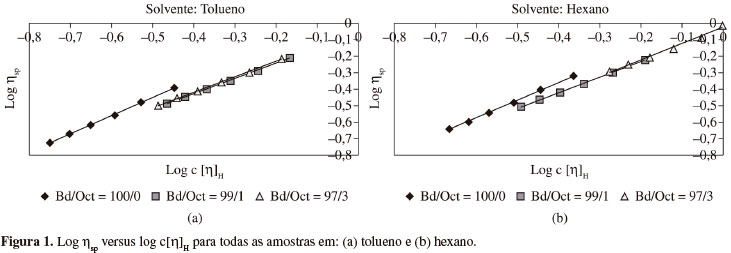Viscosimetry is a simple, inexpensive characterization method that provides valuable information about the hydrodynamic volume and conformation of macromolecules in solution, in a solvent, at a given temperature. The viscosimetric parameters can be mathematically calculated by graphic extrapolation, in time-consuming experimental tests. It is possible, however, to achieve results by a single point determination. In this work we used the two calculation methods employing a series of six equations: Huggins, Kraemer and Schulz-Blaschke, by graphic extrapolation; and Schulz-Blaschke, Solomon-Ciuta and Deb-Chanterjee, by a single point determination, for solutions of polybutadiene and of random copolymers of 1,3-butadiene and 1-octene, with different mass ratios (Bd/Oct = 99/1 and 97/3). The viscosimetric determinations were carried out in toluene and hexane, at 30 ± 0.1 °C. The weight average molecular mass was determined by size exclusion chromatography (SEC). The values of intrinsic viscosity and of some constants indicated that both toluene and hexane were good solvents for the samples, with hexane being better owing to the higher intrinsic viscosities when compared to the former. It was also observed that the method of calculation by a single point was valid. By means of the intrinsic viscosity values and the parameter g' (ratio between the viscosities of branched and linear polymer) the occurrence of branching in the copolymer chain was suggested because g'<1 and the values of intrinsic viscosity were lower than those obtained for the homopolymer.
Copolymerization; 1,3-butadiene; 1-octene; viscosimetry; one single point determination













